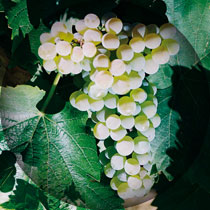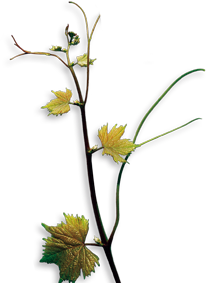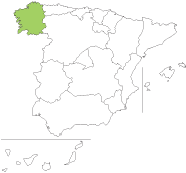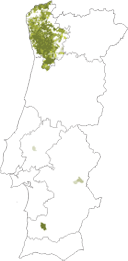Treixadura (ES) / Trajadura (PT)
Variety: white | Category III | Portugal/Spain


General Information
Treixadura


Trajadura


Origin: Galicia and Minho, according to Vila Maior (1875).
Chief areas of distribution: The entire Minho region, Galicia.
Historic and regional synonyms: Trincadente.
Homonym(s): None
Area under cultivation: 2,200 ha (PT), 600 ha (ES).
New plantings: 0.4%.
Trend: Upward.
Varietal variability: Medium.
Availability of propagating material: RNSV polyclonal material, and Clone 85 -89 RNSV available.
Molecular Profile (OIV)
Regional Classification
Morphology
Phenology
Vegetative Potential
Viticultural Parameters
Oenology
Variety Characteristics
| VVMD5 | VVMD7 | VVMD27 | VrZag62 | VrZag79 | VVS2 | ||||||
| Allele1 | Allele2 | Allele1 | Allele2 | Allele1 | Allele2 | Allele1 | Allele2 | Allele1 | Allele2 | Allele1 | Allele2 |
| 224 | 236 | 235 | 247 | 181 | 185 | 186 | 186 | 247 | 247 | 145 | 153 |
Recommended in Portugal: Galicia.
DOC quality wine: all Vinho Verde areas (except Baião)
Regional wine: Minho.
Young shoot (form of tip): Open, fuzzy, white with weak anthocyanin colouration of the end.
Young leaf: Yellow, with bronze and copper spots. Fluffy on the lower side.
Young shoot: Red stripes on the dorsal side of nodes and internodes, green buds. Short tendrils.
Inflorescence (sex of flower): Hermaphrodite.
Mature leaf: Medium size, round, entire or three lobes. Medium green blade, flat, some blistering. Medium and long convex teeth. Open U-shaped petiolar sinus. Sparse prostrate hairs and sparse erect hairs on lower side of blade.
Bunch: Medium to large, cylindrical-conical with double wings. Very thick, short peduncle.
Berry: Medium to large, ovate, yellowish green. Berry skin thin and frosted. Flesh firm and very juicy. Short peduncle.
Woody shoot: Yellowish brown.
Time of bud burst: Medium to late, 9 days after the Fernão Pires.
Flowering: Normal, 6 days after the Fernão Pires,
Berry (colour change): Late, 11 days after the Fernão Pires
Berry (harvest ripe): Normal to late.
Vigour of shoot growth: Medium to high.
Pruning weight:: Upright, some plagiotropic (drooping).
Shoot attitude (habit): Upright, some plagiotropic (drooping).
Length of internodes: Long and medium.
Shoot length: Short and medium.
Tendency to form lateral shoots: Medium.
Rate of multiple bud bursts: Zero.
Bud fertility index: On average, 1.7 flowers per shoot.
Yield: High (10,000 – 17,500 kg/ha). RNSV statistical values: 4.5 kg/vine (Average of at least 40 clones in Arcos de Valdevez over 5 years).
Yield consistency: Consistent.
Crop uniformity: Uniform.
Winkler Index: 1,227.
Sensitivity to abiotic factors: Rustic variety. Berries may burst with excessive water in the ripening phase.
Susceptibility to fungal diseases: Susceptible to Peronospora; very susceptible to Bunch Rot (Botrytis) and Excoriosis (Phomopsis viticola Sacc.).
Systemic viral infection prior to selection: 40% GLRaV-3, 40% GFkV, <50% RSPV.
Susceptibility to Pests: Aphids, mealybugs.
Bunch size: Medium to large (365 - 404 g).
Bunch density: Very dense.
Berry skin: Thick, firm.
Seeds per berry: 1.7.
Vineyard conduction system: All types of training systems.
Soil requirement: Loose, well drained soils.
Climatic requirements: Tolerates air and soil humidity, and strong sun.
Vine density: Vine spacing should always be greater than 1 m.
Rootstock: Compatible with 196-17, SO4, 161-49, R110.
Irrigation: In extreme drought conditions.
Incidence of coulure/millerandage: Susceptible (Vila Maior, 1875).
Spoilage of mature berries: Heavy rain in Autumn can cause berries to burst.
Risk of bird damage: None.
Machine harvest suitability: Not common regionally, because training systems and topography are unsuitable.
Wine type: This variety is suitable for a particular wine style: that of the Vinho Verde (light wine).
Potential alcohol content: Traditionally low (9% – 11.5% vol.). Modern training systems achieve an alcohol content of 12% - 13% vol. RNSV statistical value: 9.85% vol. (Average of at least 40 clones in Guimarães over 6 years).
Natural acidity of must: RNSV statistical value: 7.85 g/l (Average of at least 40 clones in Guimarães over 6 years).
Risk of oxidation of must: Medium.
Colour intensity of wine: Medium to intense.
Wine colour tonality: Straw to golden.
Risk of oxidation of wine: Low.
Aromatic profile: Intense. Ripe fruits.
Ageing Potential: Medium. Wine should be consumed young.
Blending recommendation: Loureiro, Arinto, Alvarinho.
Wine Descriptors: Wine with intense straw to golden colour with a powerful aroma of ripe orchard fruits (apple, pear, peach), well integrated into a warm, round, smooth taste, but from time to time slightly unbalanced due to insufficent acid (EVAG).
Wine quality: Very good quality, as long as yield is restricted.

